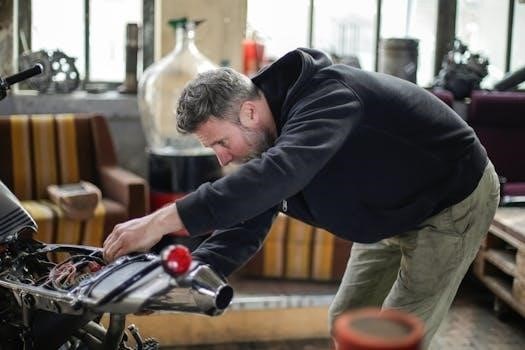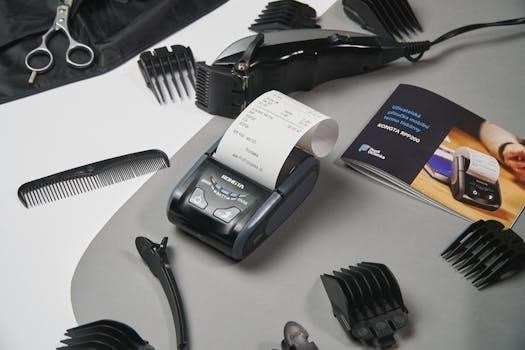
Engine chokes are vital for starting combustion engines, particularly in cold conditions. They regulate the air-fuel mixture, ensuring a rich mix for smooth starts. This article explores two common types⁚ manual and electric chokes, examining their operation, advantages, and disadvantages. Understanding these differences is key to optimizing engine performance.

Defining Engine Chokes
An engine choke is a mechanism designed to modify the air-fuel mixture entering an engine’s combustion chamber, primarily during cold starts. When an engine is cold, it requires a richer fuel mixture (more fuel and less air) to start and run smoothly. A choke valve, typically located in the carburetor, restricts the airflow, thereby increasing the fuel-to-air ratio. This ensures the engine receives the necessary fuel for ignition and initial operation. The choke is a crucial component for older vehicles with carburetors, as modern fuel-injected engines handle this process electronically. The choke’s role is temporary; once the engine warms up, it needs a leaner mixture, and the choke is gradually opened, reducing the fuel-rich condition. The ability of the choke to do its job properly directly impacts the engine’s cold-start performance, fuel efficiency, and overall drivability. Therefore, understanding the different types of chokes, their operation and the advantages and disadvantages, is necessary for proper engine operation.

Manual Choke Systems
Manual choke systems require the driver to manually adjust the choke valve using a lever or knob connected by a cable. This direct control allows for user intervention, but also introduces the possibility of human error in choke operation.
Manual Choke Operation
A manual choke system operates through a mechanical linkage, typically a cable, connecting a control inside the vehicle to a choke valve in the carburetor. When the driver activates the control, usually a lever or a knob, this cable pulls or pushes the choke plate, partially obstructing the carburetor’s air intake. This restriction enriches the fuel mixture, providing the extra fuel needed for cold starts. As the engine warms up, the driver must gradually open the choke by adjusting the control, allowing more air to enter the carburetor. Failure to adjust the choke properly can lead to over-rich conditions causing poor fuel economy and potential engine fouling, or under-rich conditions making it difficult to start or keep the engine running smoothly. Proper manual choke operation requires driver experience and knowledge for optimal engine performance.
Advantages of Manual Chokes
Manual choke systems offer several advantages, primarily their simplicity and lower cost compared to electric counterparts. Their mechanical design is straightforward, making them generally more affordable to install and maintain. The direct connection between the driver and the choke plate allows for immediate and precise control over the air-fuel mixture. This direct control is particularly useful in unusual driving conditions or with older engines that may require fine-tuned adjustments. Manual chokes are also less susceptible to electrical failures as they do not rely on electrical components, making them more robust in harsh conditions. Additionally, they allow the driver to manually adjust the choke based on real-time conditions, potentially saving fuel and reducing pollution when used correctly, as the choke can be fully opened as soon as driveability permits; This simplicity and direct control make manual chokes a reliable option for many vehicle owners.
Disadvantages of Manual Chokes
Manual choke systems, while simple, come with notable disadvantages. The primary drawback is the need for manual operation, which requires driver attention and adjustment. This can be inconvenient, especially in varying weather conditions where constant adjustments may be needed. Human error is also a factor, as incorrect choke settings can lead to over-choking or poor engine performance. The necessity of a cable running through the firewall can be cumbersome and may require additional installation effort. Manual chokes also rely on the driver’s understanding and experience to use them correctly, as misuse can result in increased fuel consumption and pollution, if not opened as soon as driveability allows. Furthermore, they lack the precision of automatic systems, potentially causing a less smooth start-up and inconsistent operation, especially when the choke is not opened at the correct time. This dependence on the driver’s skill and attention can be seen as a significant drawback.

Electric Choke Systems
Electric choke systems offer an automated approach to managing the air-fuel mixture during engine starts. They utilize a heating element, controlled by a thermostat, to regulate the choke plate. This eliminates manual adjustments, providing smoother and more efficient cold starts by adapting to engine temperature.
Electric Choke Operation
Electric chokes function by using a heating element that is typically powered by the vehicle’s electrical system. This heating element is connected to a bimetallic spring or similar mechanism, which is responsible for controlling the choke plate within the carburetor. When the engine is cold, the thermostat senses the lower temperature and allows the heating element to activate. As the element heats up, it causes the bimetallic spring to gradually relax. This action opens the choke plate, reducing the richness of the air-fuel mixture as the engine warms. The rate at which the choke opens is determined by the heating element’s design and the thermostat’s response. This process is automated, meaning it doesn’t require any manual input from the driver. The system is designed to provide a rich mixture for cold starts and then gradually lean out the mixture as the engine reaches its optimal operating temperature. The precise temperature control provided by an electric choke helps to improve fuel efficiency and reduce emissions. The vacuum choke pull down also plays a role in leaning out the mixture further, ensuring optimal performance.
Advantages of Electric Chokes
Electric chokes offer several key advantages over their manual counterparts, primarily centered around convenience and automation. One of the most significant benefits is the elimination of manual adjustments. This means the driver doesn’t have to worry about manually setting the choke before starting the engine or adjusting it as the engine warms up. The system automatically provides the correct air-fuel mixture for optimal cold starts and gradually leans it out as the engine reaches its operating temperature. This automated process leads to smoother and more efficient cold starts, reducing the risk of stalling or rough idling. Furthermore, electric chokes tend to be more precise in their operation. They are controlled by a thermostat, which responds accurately to temperature changes, ensuring the engine receives the correct air-fuel mixture at all times. This precision can lead to better fuel economy and lower emissions compared to manual chokes, which are subject to human error. The integration with the vehicle’s electrical system also simplifies installation for some applications, requiring just a single wire connection.
Disadvantages of Electric Chokes
Despite their convenience, electric chokes also have notable drawbacks. A primary concern is their reliance on electrical components, which makes them susceptible to malfunctions. Over time, the heating element, thermostat, or wiring can fail, leading to inconsistent choke operation or complete failure. This can result in hard starting, poor engine performance, or even engine damage. Another disadvantage is that electric chokes can be less adaptable to specific needs or driving conditions. They may disengage too quickly or too slowly, causing the engine to run either too lean or too rich. This can lead to poor fuel economy or rough idling. Unlike manual chokes, which allow the driver to make adjustments based on the specific situation, electric chokes operate automatically based on the temperature and cannot be manually overridden. Furthermore, while installation can be simpler in some cases, the wiring and electrical components can introduce additional points of failure, making troubleshooting more complicated than with a manual choke. Also, they can be more expensive to repair or replace compared to the simple mechanical design of manual chokes.

Comparison and Considerations
Choosing between manual and electric chokes requires careful consideration. Both systems have unique advantages and disadvantages. Factors such as cost, ease of use, and potential for malfunction play a crucial role in deciding which system best fits your needs and vehicle.
Manual vs Electric⁚ Key Differences
The primary distinction between manual and electric chokes lies in their operation and control mechanisms. A manual choke is directly operated by the driver, typically via a cable connected to a lever or knob inside the vehicle. This requires the driver to physically adjust the choke plate, controlling the air intake into the carburetor. In contrast, an electric choke uses a heating element, often a thermostat, to automatically regulate the choke plate. This system adjusts itself based on the engine’s temperature, providing a more hands-off approach. Manual chokes offer direct control and simplicity, whereas electric chokes provide convenience and automation. Electric chokes, however, are more complex and susceptible to malfunctions due to their electrical components. The manual choke is simple, cheaper, and directly adjustable by the operator, but needs driver attention. This fundamental difference in how they control the air-fuel mixture defines their advantages and disadvantages.
Factors Influencing Choice of Choke
Several factors come into play when choosing between a manual and an electric choke. Climate is a significant consideration; colder climates often benefit from the consistent, automatic operation of an electric choke, which ensures reliable cold starts. The type of carburetor also influences the choice, as some carburetors are designed for specific choke types. Maintenance considerations are also key; manual chokes are simple and less prone to electrical failure, making them easier to maintain for some. Personal preference plays a role, as some drivers prefer the direct control offered by a manual choke, while others value the convenience of an electric choke. Cost is another factor; manual chokes are generally cheaper and easier to set up. Finally, the complexity of installation is a factor; electric chokes may require more involved wiring, whereas manual chokes only need a cable connection. All of these elements should be weighed when deciding which system best suits individual needs.
Performance Considerations
When evaluating the performance of manual versus electric chokes, it’s important to note that neither system offers a performance increase once the engine reaches operating temperature. The primary function of a choke is to aid in cold starts by enriching the fuel mixture; once the engine is warm, the choke should be fully open. Manual chokes, if adjusted incorrectly, can lead to over-choking, causing fuel inefficiency or engine hesitation. Electric chokes, while automatic, can sometimes malfunction, opening too soon or staying closed for too long, which can also impact performance. A correctly adjusted manual choke allows the driver to precisely control the mixture, but this relies on the operator’s skill. The key is proper adjustment and maintenance, regardless of the choke type. Both manual and electric chokes should allow the engine to run smoothly once warmed up. The performance difference primarily lies in how reliably and efficiently they manage cold starts and transition to normal operation.